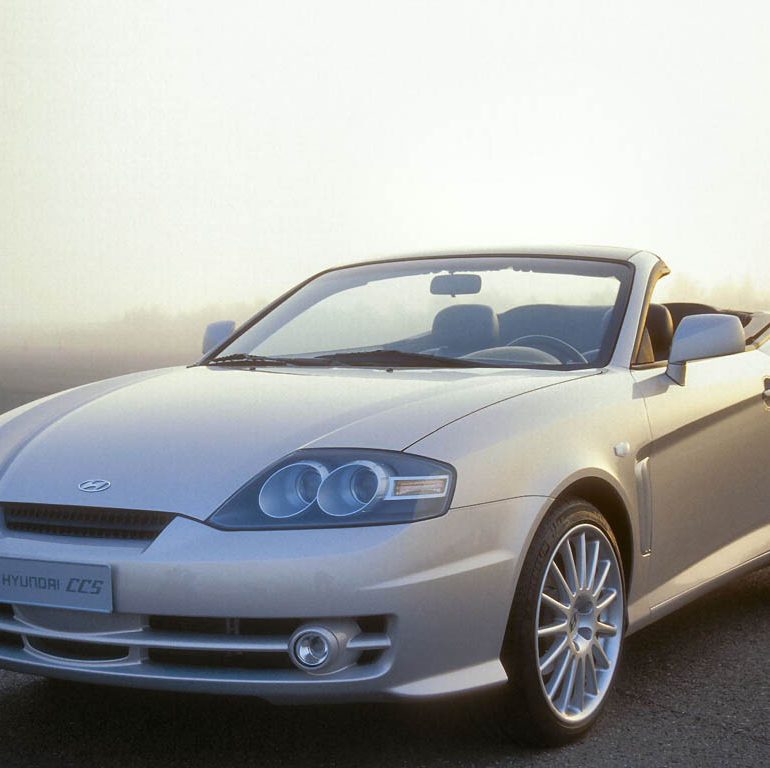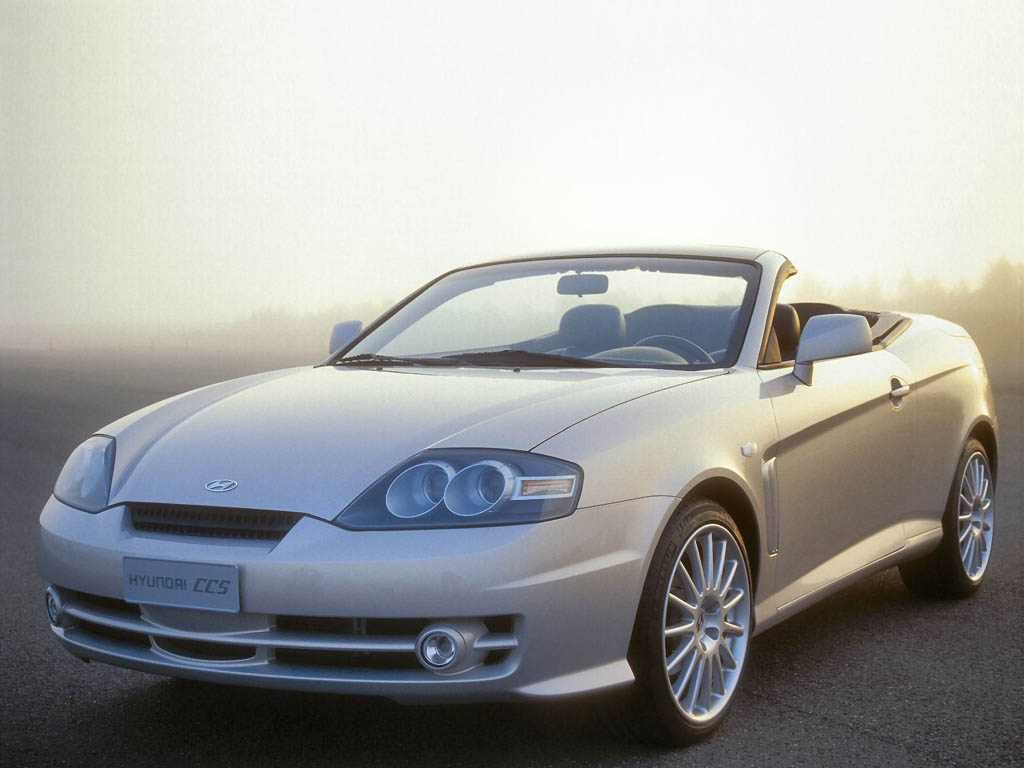2003 Hyundai CSS Concept
Based upon the admired Tiburon V6, the CCS Convertible study is a highly appealing exploration of styling and technical possibilities demonstrated by its unique three-phase slide and fold glass roof developed by renowned convertible and cabriolet specialists Karmann of Osnabruck. At the touch of a button the driver can change from glass roof, to open roof to complete top-down convertible.
The result is a car matched to any weather conditions, giving maximum occupant comfort and designed to impress, whether parked au cafe or cruising the countryside. It also previews many aspects of convertible interior and exterior styling and packaging, many of which may well influence the design of future Hyundai cars.
Roof
In folding hardtop roof terminology, the slide and folding roof system of the Hyundai CCS is the third generation. The first generation was the typical metal folding roof, the second the retractable glass roof. This third generation builds on the experience gained with the first two and refines it to offer maximum choice of open-air motoring.
In mixed weather the driver merely touches one button to send the glass roof sliding back over the rear window. By sliding outside, rather than inside, this maximises rear headroom. At this stage the side supports remain in position, so if the weather changes the roof slides quickly and smoothly back to the closed position.
From open roof to full top-down convertible demands only the touch of a second button. This folds the rear screen with the forward roof supports under the forward opening rear decking while adjusting the sliding roof panel in relation to them to give maximum luggage space. And it’s also remote controlled.
The whole process is elegantly engineered and appears deceptively simple, the key to its superiority over preceding designs. The system has less moving parts and less pivot points than earlier systems, resulting in reduced extra weight (less than 140kg over Tiburon) and the rear shelf moves only in a single plane rather than lifting or twisting.
One fascinating aspect of the roof is the potential for further development. Solar panels, or similar energy sources, are more easily assimilated than into more complex structures. Other materials, and lining methods, can be incorporated without compromising the essential benefits of the structure, so adding even more flexibility.
Sytling
Using the acclaimed styled Tiburon as a basis has helped ensure that the CCS is attractive, the most noticeable styling changes predictably aft of the doors. The slightly raised level of the boot lid/rear decking fits the folded roof while still offering the largest boot volume in the sector. Harmonious modifications to the rear flanks, taillights and front headlight clusters have been achieved, preserving the car’s distinctive lines.
New 18 inch, 15-spoke alloy wheels with 225/40 x 18 Michelin tyres give a lighter and sportier outlook. A new colour finish, Warm Silver, was developed while the paintwork shimmers with glass micro-elements.
The Hyundai CCS is a car styled to appeal to the emotions. A car that looks just as good in the car park as on the highway, a car which expresses a distinct personality and a degree of personal confidence without being aggressive.
Interior
The whole concept of the CCS Convertible is designed to give a feeling of airy space, freedom and excitement combined with personal control over precisely how much open air or weather the occupants want. This is most appreciable from inside.
Both the steering wheel and dashboard are trimmed in brown leather, adding tactile sophistication to an already well appointed and sportive office. The metallic elements, including the ventilation and a/c outlets, speaker surrounds, bezels etc., have been specially treated with a warm glow process that blends them discreetly into this ambience, again adding an extra element of refinement. A premium 280W Becker sound system and Infinity speakers provide appropriate aural pleasures.
The brown leather trimmed seats feature woven and ventilated central inserts and the front seats are Tiburon’s supportive sports style items developed with Recaro, with eight-way adjustment and memory system. The rear seats have been slightly modified to accommodate the new roof system, but the rear passenger space remains an object lesson in good convertible interior packaging.
Boot capacity is an impressive 443 litres with the roof closed and 244 litres with it folded.
Powertrain
The CCS delivers zestful performance thanks to Hyundai’s well-proven Delta 2.7 litre, all alloy quad-cam V6 which transmits up to 127kW of power and 245 Nm of torque through an Aichi-built six-speed close-ratio gearbox as fitted to the Tiburon V6.
Chassis, Safety
Due to the intrusion of the roof into the boot and the need to maximise boot capacity, the rear suspension was shortened and rearranged to give a supple but precise ride without losing the long travel smoothness and compliance of Tiburon’s suspension.
In terms of passive safety, Karmann have provided the CCS Convertible with rigidity almost matching Tiburon levels by drawing on its experience of building over two million open cars since 1949 and all of the advanced safety features of Tiburon.
Highlights
Unique glass slide and fold roof Triple mode choice: Closed, Open, or Full Convertible Remote roof control with fully automatic boot lid system New Warm Silver paintwork with micro glass chips New front and rear lights Radius R3 18 alloy wheels with Michelin 225/40×18 tyres 2+2 configuration preserved Woven leather seat inserts Leather trimmed dashboard & steering wheel Warm glow metallic interior trim elements Climate Control
Story by Hyundai Automotive
In Detail
| submitted by | Richard Owen |
| engine | Delta Tiburon V6 |
| valvetrain | DOHC |
| displacement | 2700 cc / 164.8 in³ |
| power | 127 kw / 170.3 bhp |
| specific output | 63.07 bhp per litre |
| torque | 245 nm / 180.7 ft lbs |
| front tires | Michelin 225/40×18 tyres |
| rear tires | Michelin 225/40×18 tyres Not Available |
| f brake size | mm / in |
| r brake size | mm / in |
| wheelbase | 2530 mm / 99.6 in |
| length | 4395 mm / 173.0 in |
| width | 1760 mm / 69.3 in |
| height | 11330 mm / 446.1 in |
| gear ratios | :1 |





